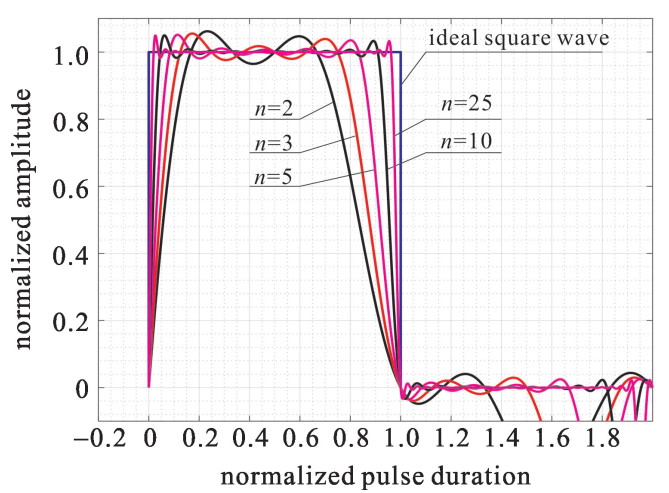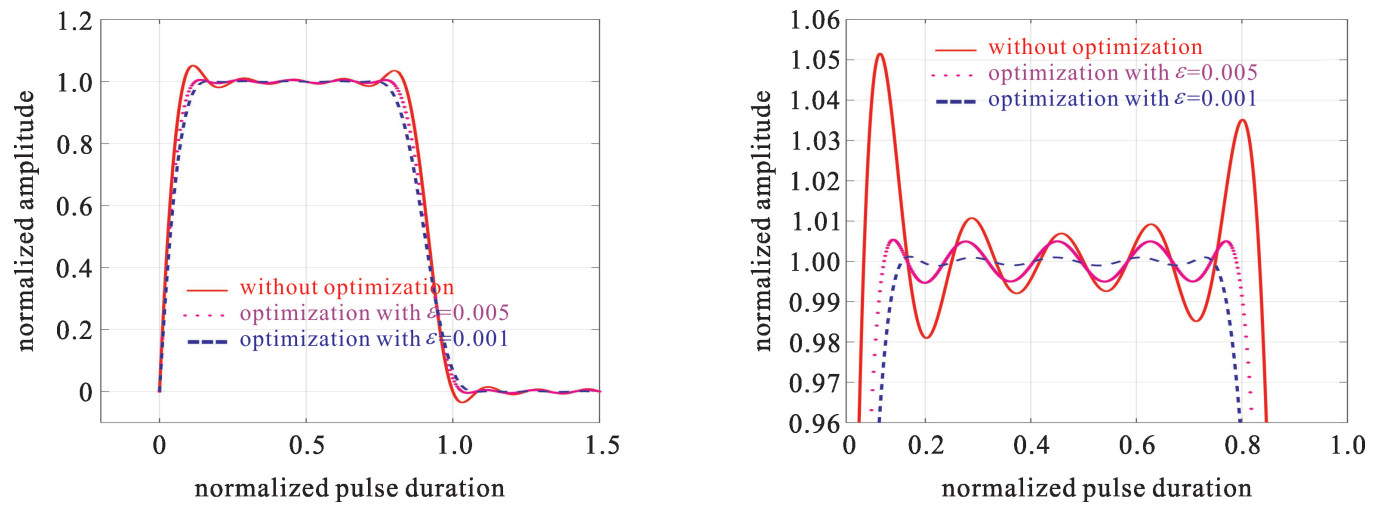Theoretical analysis and design of the trapezoidal pulse forming network
-
摘要: 针对微波驱动源、固态调制器等对宽平顶脉冲源的应用需求,开展了基于脉冲形成网络输出准方波的理论研究与分析设计。首先采用Prony算法获得准方波波形的解析表达式,然后基于最佳一致逼近的优化控制思路,列出极点控制方程,采用数值方法求解非线性方程组,获得优化波形参数。在此基础上采用阻抗函数匹配的算法求解出脉冲形成网络的元件参数初始值,根据工程设计的实际情况舍弃部分参数并对个别参数进行优化后,获得最终的元器件参数。通过理论分析与数值模拟相结合的方法,系统地给出了获取长脉宽、低纹波准方波脉冲形成网络的设计方法以及设计准则。该方法可用于设计任意阶低纹波系数的准方波脉冲源,也可用于设计其他输出波形要求的脉冲源。Abstract: For the application requirements of the high voltage pulse generator based on the pulse forming network(PFN) in the microwave driver and the solid-state modulator, the theory of the PFN with the trapezoidal pulse output was developed. First, the analytical expression of the trapezoidal pulse was obtained by the Prony algorithm. Secondly, the waveform parameters were optimized by using the best uniform approximation algorithm based on the equations of the optimal control with the maximum and minimum of the output wave, and solving these nonlinear equations with the Newton iteration method or other numerical methods. Then, the initial parameters of the PFN were worked out with the method of impedance matching. The final components parameters were obtained by rejecting some secondary parameters and adjusting a few of the main parameters. The method and criteria of the design for a PFN with the low ripple trapezoidal pulse output were proposed by theoretical analysis and numerical simulation. The results show that the proposed method can be used to design the PFN with any order and low ripple, and it can be used to design not only the pulse source with trapezoidal pulse output, but also the pulse sources with other pulse output.
-
表 1 Prony算法直接拟合所得复振幅和复频率
Table 1. Results of amplitudes and frequencies obtained by Prony algorithm
A1 A2 A3 A4 A5 A6 A7 A8 A9 A10 0.004 199
-0.014 816i0.004 199
+0.014 816i0.020 346
-0.033 943i0.020 346
+0.033 943i0.067 039
-0.070 089i0.067 039
+0.070 089i0.238 64
-0.221 1i0.238 64
+0.221 1i-0.330 22
-2.036 1i-0.330 22
+2.036 1iα1 α2 α3 α4 α5 α6 α7 α8 α9 α10 -0.051 922
+30.519i-0.051 922
-30.519i-0.217 84
+23.345i-0.217 84
-23.345i-0.537 27
+16.189i-0.537 27
-16.189i-1.125 6
+9.109 6i-1.125 6
-9.109 6i-2.226 3
+2.600 5i-2.226 3
-2.600 5i表 2 最佳一致逼近优化所得复振幅
Table 2. Results of amplitudes obtained by best uniform approximation algorithm
ε A1 A2 A3 A4 A5 A6 A7 A8 A9 A10 0.005 0.004 213
-0.008 190i0.004 213
+0.008 190i0.016 645
-0.020 462i0.016 645
+0.020 462i0.059 499
-0.051 987i0.059 499
+0.051 987i0.230 59
-0.196 64i0.230 59
+0.196 64i-0.310 95
-2.007 5i-0.310 95
+2.007 5i0.001 0.002 448 4
-0.003 337 2i0.002 448 4
+0.003 337 2i0.0130 59
-0.012 782i0.013 059
+0.012 782i0.053 507
-0.040 342i0.053 507
+0.040 342i0.224 76
-0.178 59i0.224 76
+0.178 59i-0.293 78
-1.984 5i-0.293 78
+1.984 5i表 3 直接匹配求解出的五级B型脉冲形成网络参数(ε=0.001)
Table 3. Parameters of devices in 5- stage B-type PFN with ε=0.001
L1 L2 L3 L4 L5 C1 C2 C3 C4 C5 0.121 8 0.058 6 0.059 6 0.068 4 0.095 3 0.066 7 0.057 9 0.063 0 0.077 6 0.145 0 R1 R2 R3 R4 R5 G1 G2 G3 G4 G5 0.019 5 -0.007 4 0.000 6 0.000 6 -0.004 2 0.014 1 -0.001 9 0.001 1 -0.000 9 -0.012 4 表 4 五级B型脉冲形成网络优化后参数
Table 4. Optimized parameters of devices in 5- stage B-type PFN
ε L1 L2 L3 L4 L5 C1 C2 C3 C4 C5 0.005 0.102 4 0.056 2 0.061 4 0.070 9 0.098 6 0.059 3 0.058 8 0.065 8 0.081 1 0.151 4 0.001 0.126 7 0.058 6 0.059 6 0.068 4 0.095 3 0.066 7 0.057 9 0.063 0 0.077 6 0.145 0 表 5 五级B型脉冲形成网络优化后输出脉冲波形特征参数
Table 5. Features of output pulses in simulation circuit of Fig. 5
ε(designed) tri(10%~90%) tfi(90%~10%) tw1(10%~10%) tw2(100%~100%) ε(simulated) 0.005 0.070 0.137 0.964 0.670 0.006 8 0.001 0.089 0.169 0.988 0.584 0.001 3 -
[1] 龙霞锋, 刘永贵. Marx型脉冲形成网络的研究[J]. 中国物理C, 2008, 32 (s1): 274-276. https://www.cnki.com.cn/Article/CJFDTOTAL-KNWL2008S1092.htmLong Xiafeng, Liu Yonggui. Investigation of Marx-PFN. Chinese Physics C, 2008, 32 (s1): 274-276 https://www.cnki.com.cn/Article/CJFDTOTAL-KNWL2008S1092.htm [2] 李志强, 杨建华, 张建德, 等. 紧凑重频PFN-Marx脉冲发生器[J]. 强激光与粒子束, 2016, 28: 015013. doi: 10.11884/HPLPB201628.015013Li Zhiqiang, Yang Jianhua, Zhang Jiande, et al. A compact repetitive PFN-Marx generator. High Power Laser and Particle Beams, 2016, 28: 015013 doi: 10.11884/HPLPB201628.015013 [3] 黄华, 范植开, 马乔生, 等. 长脉冲相对论速调管放大器的初步实验研究[J]. 强激光与粒子束, 2002, 14 (6): 915-919. http://www.hplpb.com.cn/article/id/1409Huang Hua, Fan Zhikai, Ma Qiaosheng, et al. Progress on a long pulse relativistic klystron amplifier. High Power Laser and Particle Beams, 2002, 14 (6): 915-919 http://www.hplpb.com.cn/article/id/1409 [4] 田景昌, 宋小泉, 李自良. HPM脉冲形成网络的理论分析与计算[J]. 飞行器测控学报, 2003, 22 (3): 72-74.Tian Jingchang, Song Xiaoquan, Li Ziliang. Theoretical analysis and calculation of HPM pulse forming network. Journal of Spacecraft TT&C Technology, 2003, 22 (3): 72-74 [5] 吴谨, 万重怡. 紫外预电离TE(A)CO2激光器自持辉光放电的阻抗计算[J]. 激光杂志, 2002, 23 (2): 15-17. https://www.cnki.com.cn/Article/CJFDTOTAL-JGZZ200202005.htmWu Jin, Wan Chongyi. Calculation of the glow discharge impedance of a UV-preionized self-sustained TE(A)CO2 laser. Laser Journal, 2002, 23 (2): 15-17 https://www.cnki.com.cn/Article/CJFDTOTAL-JGZZ200202005.htm [6] 刘锡三. 高功率脉冲技术[M]. 北京: 国防工业出版社, 2005: 116-119.Liu Xishan. High pulsed power technology. Beijing: National Defense Industry Press, 2005: 116-119 [7] 王朋, 李名加, 康强, 等. L型脉冲形成网络的仿真与实验研究[J]. 强激光与粒子束, 2013, 25 (9): 2461-2465. doi: 10.3788/HPLPB20132509.2461Wang Peng, Li Mingjia, Kang Qiang, et al. Simulation and experimental research on L-type pulse forming network. High Power Laser and Particle Beams, 2013, 25 (9): 2461-2465 doi: 10.3788/HPLPB20132509.2461 [8] 程道国. 脉冲形成网络设计中的若干问题[J]. 现代电子, 1998, 63 (2): 22-27. https://www.cnki.com.cn/Article/CJFDTOTAL-LDKJ199802005.htmCheng Daoguo. Some problem in design of pulse forming network. Modern Electronics, 1998, 63 (2): 22-27 https://www.cnki.com.cn/Article/CJFDTOTAL-LDKJ199802005.htm [9] 李洪涛, 王传伟, 王凌云, 等. 500 kV全固态Marx发生器[J]. 强激光与粒子束, 2012, 24 (4): 917-920. doi: 10.11884/HPLPB202133.200223Li Hongtao, Wang Chuanwei, Wang Lingyun, et al. 50 kV all-solid-state Marx generator. High Power Laser and Particle Beams, 2012, 24 (4): 917-920 doi: 10.11884/HPLPB202133.200223 [10] 徐利治, 王仁宏, 周蕴时. 函数逼近的理论与方法[M]. 上海: 上海科学技术出版社, 1983: 246-250.Xu Lizhi, Wang Renhong, Zhou Yunshi. The theory and method of function approximation. Shanghai: Shanghai Scientific and Technical Publishers, 1983: 246-250 [11] 李庆杨, 王能超, 易大义. 数值分析[M]. 4版. 北京: 清华大学出版社, 2001: 78-83, 287-288.Li Qingyang, Wang Nengchao, Yi Dayi. Numerical analysis. 4th ed. Beijing: Tsinghua University Press, 2001: 78-83, 287-288 [12] Smith P W. Transient electronics: pulsed circuit technology[M]. New York: John Wiley & Sons Ltd, 2011: 107-136. -





 下载:
下载:







